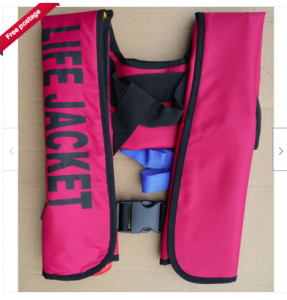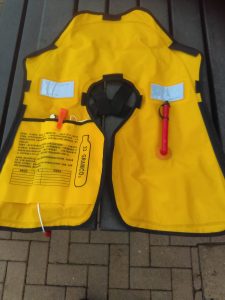My recent client will not mind me posting these photographs, nor writing about this subject. The client, a novice sailor was keen to learn and so decided to buy his own lifejacket for a course with OneOcean and on arrival presented the jacket to me for inspection prior to fitting.
It looked like a lifejacket and on the front in big bold writing was the word LIFEJACKET. It was red in colour with black straps. No crotch straps.
On closer inspection I saw that there was no CE mark nor ISO on the lifejacket – neither on the outside nor inside.
When I opened the lifejacket I was stunned with what I read – or more importantly what I could not read. All the text was in Chinese.
There was no way I could check to see if this lifejacket complied with any certification.
Without the ISO mark nor the CE mark or the SOLAS wheel there was no way the wearer could guarantee that the lifejacket has passed the rigorous testing that is required to be awarded these certifications.
This was not a lifejacket, but a deathjacket.


In the event of an emergency, a Man Over Board situation or if the wearer entered the water there is a possibility this jacket would not deploy. It may deploy but the fabric may not be strong enough to take the pressure of the CO2 cylinder – IF the cylinder has any CO2 in it, and if the deployment mechanism works.
Entering the water in any condition is a fearful situation, and in an emergency it is imperative that you have the correct equipment to assist you with your survival. Otherwise, the chances of survival are drastically reduced.
These factors are not worth even thinking about when going to sea. So the message is clear : do not buy cheap lifejackets.
The client was horrified and said he would buy a new lifejacket immediately. I advised him that a lifejacket would cost him in the range of £60-£130 depending on what he required, but he needed to ensure that the ISO, CE Mark or SOLAS wheel was marked clearly on the lifejacket.
He bought this lifejacket for less than £20.
My advice is always : spend as much as you can on life saving equipment as one day your life will depend on it.
Read Meuryn Hughes’ 2012 article in Powerboat and RHIB magazine about Lifejackets :
Lifejacketsordeathjackets – Meuryn Hughes Article
Since July 1995, it has been illegal to sell Lifejackets or Buoyancy Aids that have not been tested to European or International specifications.
There are several classifications for ISO Approval.
CE standards deal with various categories of buoyancy performance, the big four are shown below. The rating is for an adult size so smaller sizes have proportionally less buoyancy:
ISO12402-5, covers 50N buoyancy aids, providing a minimum of 5kg of buoyancy.
ISO12402-4, covers 100N lifejackets, providing a minimum of 10kg of buoyancy.
ISO12402-3, covers 150N lifejackets, providing a minimum of 15kg of buoyancy.
ISO12402-2, covers 275N lifejackets, providing a minimum of 27.5kg of buoyancy.
Buoyancy explained
Newtons, are a measure of force. 10 Newtons (or 10N in lifejacket speak) is equivalent to 1 kilogram of buoyancy. So a 150 Newton lifejacket (or 150N) provides 15kg of buoyancy. Remember these are the minimum buoyancy requirements for the European standard, so the actual vest or lifejacket may provide more.
Children’s life jackets are commonly rated as 100N or 150N but they don’t actually have that much buoyancy. For example a kids foam lifejacket size 10-20kg has 30N of buoyancy.
What else does ISO approval cover?
ISO approval also covers other features not just buoyancy ratings. These include the design, performance, specification of materials used in manufacture, and even the information that the user guide provides.
Further reading:
Lifejacket Maintenance Leaflet